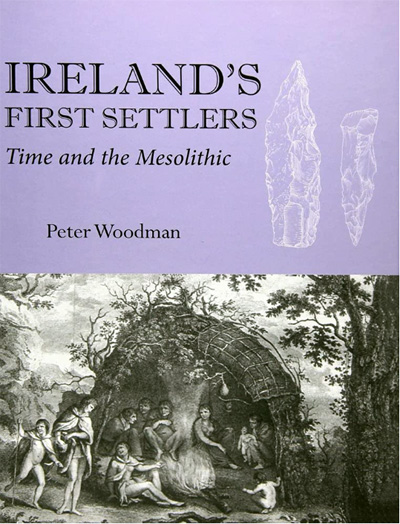Find may change theory on early man in Ireland
An article by Dick Hogan printed in The Irish Times 18 June 1983Carbon testing of three shell middens found in the Ferriter Cove area of the Dingle peninsula in County Kerry may reveal that man arrived in the south-west much earlier than 2,000 BC.
If the dating proves positive, Professor Peter Woodman, of University College, Cork, said yesterday existing theories as to how early man first came to Ireland might have to be revised.
Professor Woodman made the discovery while working with a UCC team in the peninsula as part of the Ballyferriter Co-Op archaeological survey. He said yesterday that the three shell middens found by the team showed that early inhabitants ate shellfish and because of the existence of fish bones, had probably developed a means of fishing. There was also evidence that the inhabitants developed a stone tool industry, using stone from volcanic rock in the area known as rhyolite. It's a bit like cracking a code, if you don't know what people were using, it becomes all the more difficult to know what to look for. This is potentially a find of considerable importance because it may alter the existing theories as to how man came to Ireland in the first place.
It, for instance, we can show that this part of the south-west was occupied early as other parts of the country, then obviously, we will have to think again about the way the first inhabitants entered the country. It is a bit like looking into a black hole with one chink of light.
Until the results of the three separate carbon 14 tests are returned, we won't be in a position to add much more, Professor Woodman said.
Fragments from the find will be sent he said, to a research laboratory in Britain and it could be some months before the detailed examination is completed. Professor Woodman said the popular theory was that early man entered Ireland through the north and gradually spread southward. He added that this theory might no longer hold if the tests show that the south-west was inhabited substantially earlier than 2000 BC "the key question is how much earlier." The find coincides with news from the archaeological survey of the dingle peninsula that almost 800 either forgotten or hitherto unknown sites have now been logged by the Ballyferriter Co-Op team.
The team, headed by Ms Judith Cuppage, is expected is complete the survey of the peninsula which cost £100,000, by the end of next year. By then, it is expected that almost 2,000 sites will have been catalogued in the first comprehensive study of this architecturally rich area.
Ms Cuppage said yesterday that the team had already identified megalithic tombs, standing stones, pre-bob field systems, promotory forts, clochans and ring forts. As well, using old reference works. The team of nine has rediscovered some important archaeological sites in the area. For instance, after an old photograph was sent from the United States, the head master of the local Christian Brothers' school in Ballyferriter recognised that a large stone covering a drain in the school was in fact the early Christian cross slab depicted in the photograph. The Ballyferriter survey will cover an area of 217 square miles, including the Balsket islands.
 Ireland's First Settlers: Time and the Mesolithic
by Peter Woodman tells the story of the archaeology and history of the first continuous phase of Ireland’s human settlement.
It combines centuries of search and speculation about human antiquity in Ireland with a review of what is
known today about the Irish Mesolithic. This is, in part, provided in the context of the author's 50 years
of personal experience searching to make sense of what initially appeared to be little more than a collection of beach rolled and battered flint tools.
Ireland's First Settlers: Time and the Mesolithic
by Peter Woodman tells the story of the archaeology and history of the first continuous phase of Ireland’s human settlement.
It combines centuries of search and speculation about human antiquity in Ireland with a review of what is
known today about the Irish Mesolithic. This is, in part, provided in the context of the author's 50 years
of personal experience searching to make sense of what initially appeared to be little more than a collection of beach rolled and battered flint tools.
The story is embedded in how the island of Ireland, its position, distinct landscape and ecology impacted on when and how Ireland was colonized. It also explores how these first settlers evolved their technologies and lifeways to suit the narrow range of abundant resources that were available.
The volume concludes with discussions on how the landscape should be searched for the often ephemeral traces of these early settlers and how sites should be excavated. It asks what we really know about the thoughts and life of the people themselves and what happened to them as farming began to be introduced.
Purchase at Amazon.com or Amazon.co.uk
Boyne Valley Private Day Tour
 Immerse yourself in the rich heritage and culture of the Boyne Valley with our full-day private tours.
Visit Newgrange World Heritage site, explore the Hill of Slane, where Saint Patrick famously lit the Paschal fire.
Discover the Hill of Tara, the ancient seat of power for the High Kings of Ireland.
Book Now
Immerse yourself in the rich heritage and culture of the Boyne Valley with our full-day private tours.
Visit Newgrange World Heritage site, explore the Hill of Slane, where Saint Patrick famously lit the Paschal fire.
Discover the Hill of Tara, the ancient seat of power for the High Kings of Ireland.
Book Now
Home
| Visitor Centre
| Tours
| Winter Solstice
| Solstice Lottery
| Images
| Local Area
| News
| Knowth
| Dowth
| Articles
| Art
| Books
| Directions
| Accommodation
| Contact

